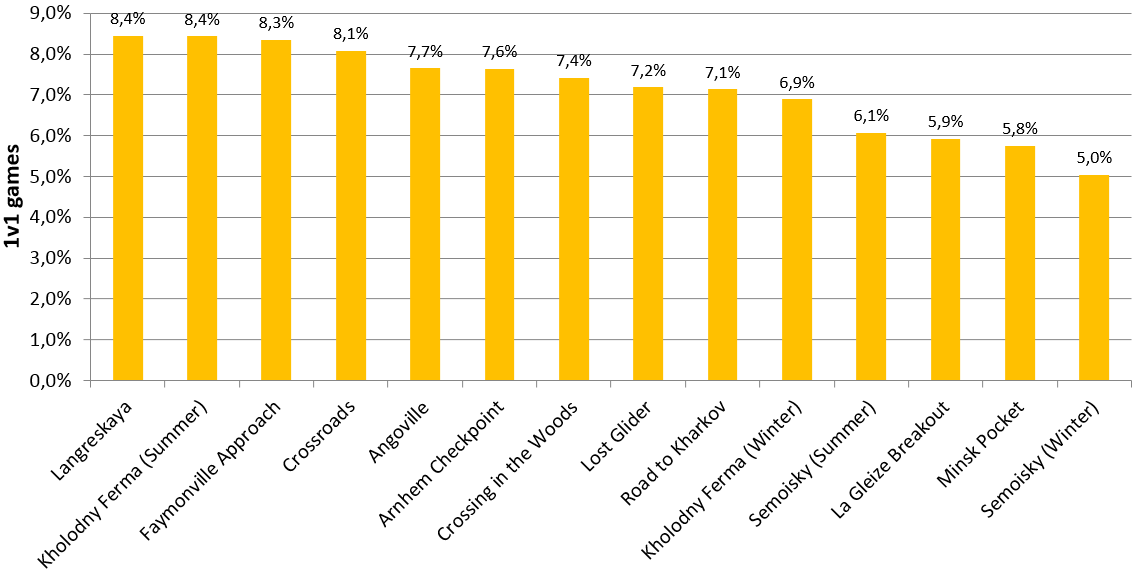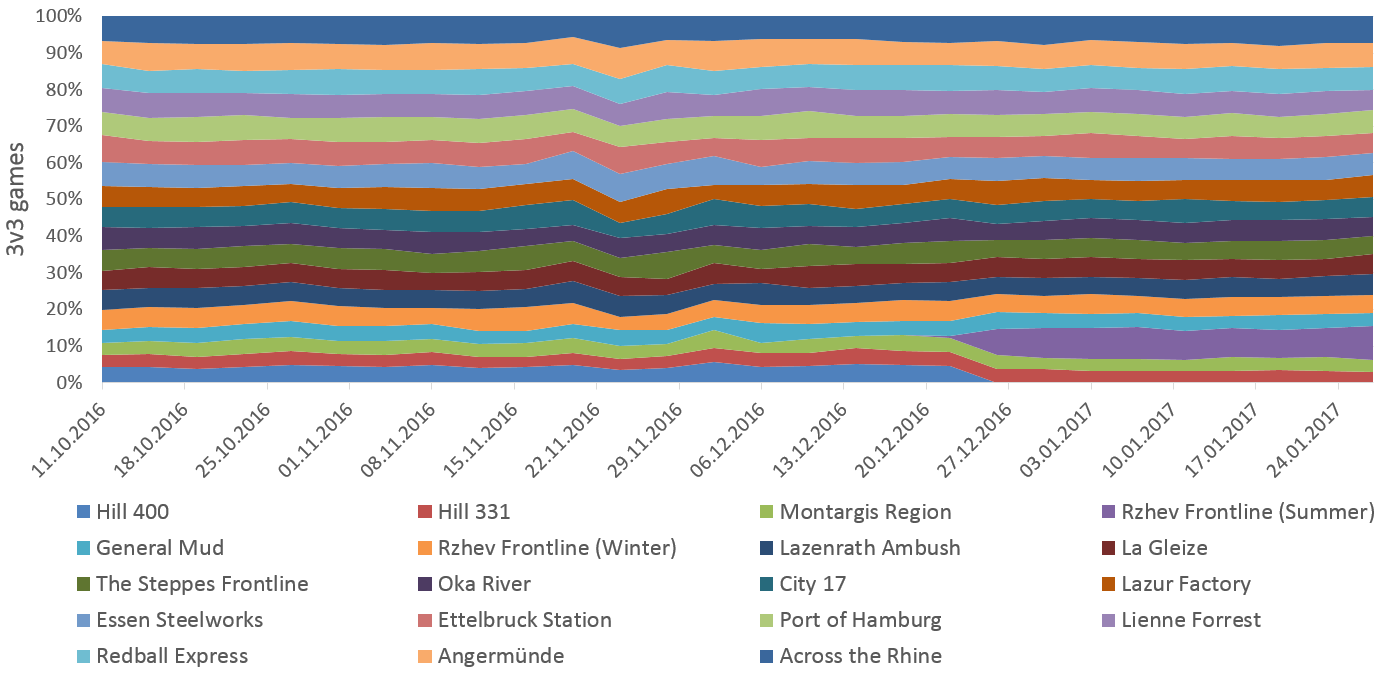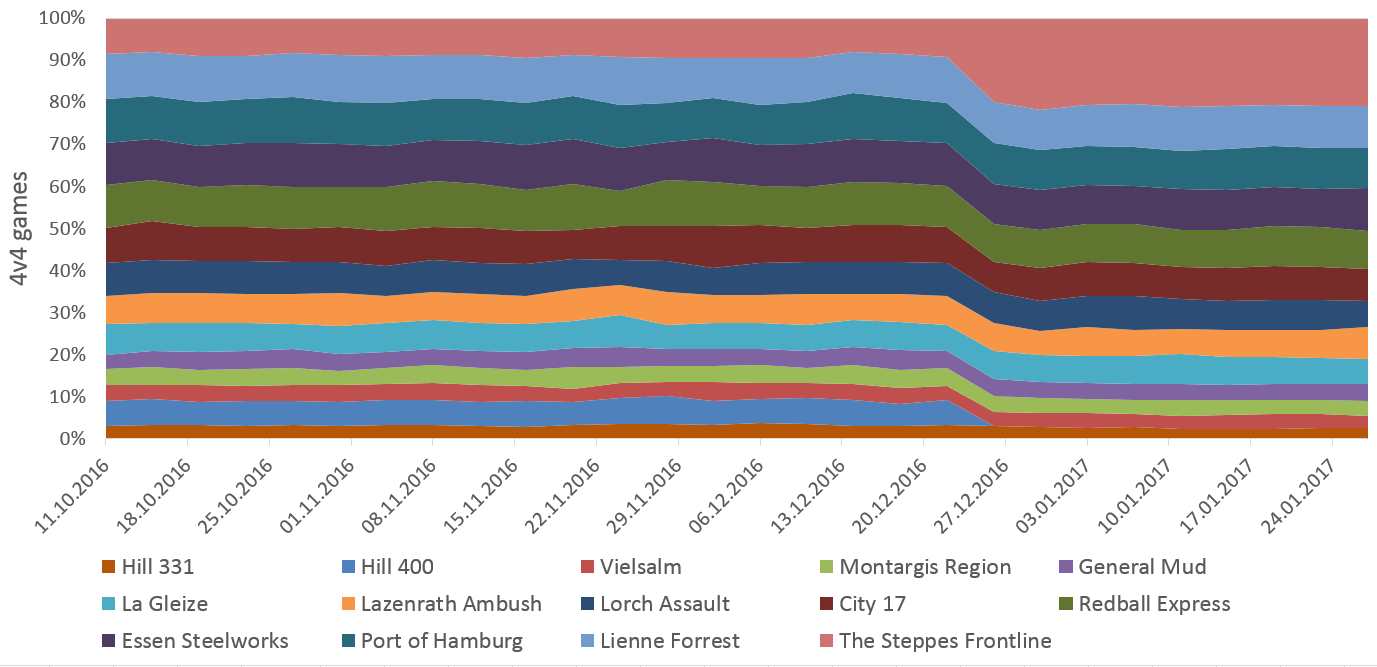The data presented in here was captured from the game history of all players that have a rank on the ladder. In most sections, the diagrams will present data from two time ranges: 25th of May 2015 to the 25th of October, before the 1v1 and 2v2 map pool was changed, and then from the 22nd of December to the 28th of February 2017, after the inclusion of the new 1v1 and 2v2 maps.
How do vetoes work
Relic has given some information on the subject of vetoes in this thread. In particular, Cuddletronic says:
| !I think there may be a misunderstanding on how Map Veto actually works. Just because you have voted to veto a Map doesn't mean you will not play on that map. "A Veto counts as a single vote against a Map. When creating a Match, the Automatcher will only select among maps that have the fewest amounts of Vetoes" Basically, the Server sums up the total number of Vetoes for each map for everyone, then generates the set of maps with the least number of vetoes, and randomly choose one of them. |
Unfortunately, he does not specify who "everyone" is. In the same thread Kyle_RE says that it would be everybody currently searching the for a match. This seems unlikely because:
- Unless everybody is vetoing the same maps, it would be a common occurrence to play a "vetoed map".
- The process is needlessly complex and yields a worse result.
Instead, I think it is more likely that "everyone" only includes the players that are in that game. If that is the case, the scheme would work like this:
- The matchmaking algorithm matches players based on their hidden ELO only, ignoring map vetoes.
- A map that received the least vetoes from all players in this match is selected.
This would mean that in 1v1s, you never play on a map that you veto. In 4v4, however, there are 13 maps in the pool vs. a grand total of 32 vetoes between all eight players, so a vetoed map could be chosen. Similarly, we have we have 24 vetoes vs. 20 maps in 2v2, and 30 vetoes vs. 17 maps in 3v3.
There seems to be an occasional hiccup on the server side when it comes to map selection, as discussed later in the article and in this thread.
On the win percentages...
Some of the diagrams show the difference from the average win percentage for that faction. These values give some idea of how successful a faction is on average playing the individual maps. These values should be taken with a grain of salt, mostly because certain features of the map might play out differently at different skill levels. So, a map that is problematic for e.g. Soviets at a lower skill level might be easy to deal with for top players.
Note that once a match is made, there are several factors that determine the chance of winning which are likely more important:
- The skill level of the opponent
- The faction matchup or in team games the faction composition
- The starting position (the match history data does not seem to indicate the starting position of the player)
- Disconnects
As we will see, in most cases the percentages a similar between factions on either the axis or allied side. This is due to two effects:
- If a map is bad for a certain faction, all factions on the other side will benefit.
- In team games, factions are mixed anyways; consequently, win rates become more similar with larger team sizes.
The diagrams also contain bars indicating estimates for the standard deviations. However, no attempt was made to capture the granularity of the problem when using the bootstrap method to compute those. They mostly serve as a reminder not to take the percentages too literally due to the sample size.
The related diagrams show "the difference in the win percentage to the average win percentage for a faction", but the values will be referred to as "win percentages" at times for brevity.
1v1

The diagram above shows the how often the different maps have been played per faction. The total number of games for the period from May to October is a little above 362k. The most obvious feature here is that OH was played more often than OKW, while UKF was significantly less popular in 1v1 than USF and SOV.

The diagram above shows the games per map as percentages of the total number of games with the factions. The most popular maps are Langreskaya, Kholodny Ferma (Summer), Faymonville Approach and Crossroads. The maps vetoed most are La Gleize Breakout, Minsk Pocket, and both Semoisky maps. However, even the least played maps are still played more than half as often as the most played map. This changes for team games as we will see in the sections below.

This chart shows how the percentage difference per faction to the average across all factions is (as a percent of the games for that faction). The differences are small, potentially too small to be significant. Crossroads relatively seems to be vetoed more with Soviets than with the other factions and Semoisky (Summer) is less popular with USF.

The diagrams above display win percentages as a difference from each faction’s average. On most maps, the win percentages have a near negligible difference from the average winrate. Notable differences are:
- Ostheer seems to enjoy an above average win percentage on Faymonville Approach and Semoisky (Summer) while having a hard time on La Gleize Breakout, and maybe Minsk Pocket and Arnhem Checkpoint.
- OKW apparently does well on Minsk Pocket, Road to Kharkov and Semoisky (Summer) while struggling on La Gleize Breakout and possibly on Faymonville Approach, Arnhem Checkpoint, and Lost Glider.
- Soviets seem to be very successful on La Gleize Breakout and possibly Lost Glider, while losing out on Crossing in the Woods.
- Numbers indicate that USF is doing reasonably well on Faymonville Approach, Crossroads, La Gleize Breakout and Minsk Pocket while suffering on both Semoisky versions and possibly on Road to Kharkov and Langreskaya.
- UKF is doing particularly well on Arnhem Checkpoint and maybe La Gleize Breakout and Lost Glider. Win percentages seem to be below average on Minsk Pocket, Angoville and potentially on both Kholodny Fermas.
The least balanced map seems to be La Gleize Breakout. Not surprisingly, it is not played often. However, it still was played more than Semoisky (Winter), which does not seem to be as bad in terms of faction balance and is often featured in map pools of 1v1 tournaments.
The previous diagrams are for the period before the 25th of October. In that patch, new 1v1 maps have been introduced to the pool. Most of these were subsequently refined and updated in the patch on the 22nd of December, together with the introduction of the map Halbe. The diagrams below show the situation after the 22nd (up to the 28th of February).

Halbe, Westwall, and Caen are the more popular new maps, ending up just behind the former last of the midfield, Kholodny Ferma (Winter). The less popular Bryansk Forest, Bombarded Refinery, and Market Ruins come in before Semoisky (Winter), while Rüstungswerke Essen is now the most vetoed map. Most of the new maps — with the exception of Bombarded Refinery and Market Ruins — are more frequently vetoed when playing OH than OKW.

Most of the new maps are played by all factions about the same amount. However, Halbe is less popular with OH, while being played more by OKW and UKF. Caen again seems to be more popular with OKW, as is Market Ruins with UKF.

The diagrams above show the win percentages after the 22nd. These values are far less reliable than those shown earlier as indicated by the error bars. This is because the overall number of games is more than a factor of three lower and these fewer games are distributed over significantly more maps.
While we have to be careful with definitive statements, the numbers seem to indicate that Halbe favors OKW. Playing OH might be challenging on Caen. The Soviets seem to do particularly well on Caen, but poorly on Halbe and Market Ruins. USF apparently was rather unsuccessful on Halbe while doing well on Market Ruins, Bryansk Forest and Bombarded Refinery. Finally, UKF won more often on Halbe and did worst on Bryansk Forest.
2v2

The diagram above shows the number of 2v2 games played per map and faction up to the 25th of October, a total of almost 430k games. The popularity difference between OH and OKW has been significantly reduced while UKF is almost on par with SOV while USF falls behind.

The most played 2v2 maps are Rails & Metal, Road to Kharkov, and Crossing in the Woods. The second tier consists of Moscow Outskirts (Summer), Minsk Pocket and possibly Vaux Farmlands. The most vetoed maps are Ettelbruck Station, Lierneux, Rzev Frontline, Gelsenkirchen Refinery and Düsseldorf.
It is noteworthy that Minsk Pocket, which was among the least popular maps for 1v1, is fairly popular in 2v2. Likewise, Road to Kharkov rates higher in 2v2 than in 1v1. A key difference from the 1v1 map data is the larger difference between the most and the least popular.

The percentages show that there are even fewer differences between factions’ map preferences as in 1v1, likely due to teams often being mixed. This trend continues for the higher game modes so this type of chart will be omitted in the following.

The diagrams above show the win percentages of the factions on the different 2v2 maps. A comparison to the 1v1 curves indicates that map/faction balance seems to be a bigger issue in 2v2. The percentages for 1v1 are mostly in the range from -1% to +1% with a few outliers. For 2v2, the values commonly exceed this range, in particular for UKF and OKW.
This might be partially because 1v1 maps received more refinements over the years because this mode is perceived as more competitive. Moreover, balancing team maps could be more tricky due to varying team compositions resulting in different synergies. The main offenders are Ettelbruck Station, on which both axis faction do poorly while UKF enjoys a high win percentage and Gelsenkirchen Refinery which favors the Germans.
Apart from these two maps (mentioning only deviations over 2% because otherwise, the list would be too long):
- Maps are overall reasonably well balanced for Ostheer.
- OKW seems to do well on Vaux Farmlands and Across the Rhine while achieving subpar percentages on Trois Pont, Hamlet, and Semoisky (Winter).
- The Soviets do not too good on Rails & Metal and Across the Rhine, while apparently winning more often on Trois Pont, Hamlet and Semoisky (Winter).
- USF achieves good win rates on Hamlet and Semoisky (Winter).
- UKF does well on Road to Kharkov and Semoisky (Winter); the faction is not overly successful on Moskow Outskirts (Summer) and Vaux Farmlands,
Chateau de Luvnest was removed from the 2v2 pool on the 25th of October, likely because it received some criticism from the players due to its liberal use of mud. However, it was neither wholly unpopular nor particularly unbalanced between the different factions.

While this map was removed, several new maps have been added to the 2v2 pool on the 22nd of December. The diagram above shows the percentage number of games per map for the period up to the 28th of February.
Elst Outskirts was the most popular out of the new maps, finding itself in the group of least vetoed maps. Schilberg Outskirts and Lisores River were also quite successful, and even the most vetoed out of the new maps, Pripyat Sector, was more popular than many of the older maps.

As mentioned earlier, win percentages are not overly reliable due to the much smaller number of games compared with the period up to October. Still, the new maps seem to be reasonably well balanced compared to the state of the other maps. In fact, Elst Outskirts appears to be almost perfect in that respect.
3v3

The diagram shows the number of games per map as a percent of the total games. The total number of 3v3 games in the period up to October is about 275k. Since factions are more and more mixed in the larger games modes, there is no significant difference in maps between factions anymore. The faction distribution in 3v3 is similar to that of 2v2 with OH slightly leading over OKW and SOV being almost tied with UKF for first and USF coming in on third place.
The least vetoed map by a small but significant margin is Across the Rhine, followed by Angermünde. The second tier of 3v3 maps consists of Redball Express, Lienne Forest, Ettelbruck Station, Port of Hamburg and Essen Steelworks. The most vetoed maps — by a margin — are General Mud, Montargis Region and Hill 331.

The diagrams above shows the win percentages per map and faction. There are no significant differences between the allied or axis factions in this gamemode, likely because teams will tend to consist of mixed factions even more compared with modes involving fewer players.
Compared with the 2v2 results, the maps seems to be balanced better with only a few maps deviating strongly from the average win percentage. Similar to 2v2, Ettelbruck Station seems to be the least balanced map by being strongly in favor of the allied factions. Interestingly, it is among the more often played maps. A close second in terms of faction imbalance is General Mud, which seems to be axis favored. The percentages further indicate that Hill 331 and Steppes Frontline might be easier to play for axis.
The patch on the 22nd of December was not supposed to change the 3v3 map pool in any way, but if we plot the map played per three days we see that there was some issue introduced then:

As we can see, Hill 400 suddenly disappears on the 22nd while Rzhev (Summer) apparently is in the map pool. Given that it currently not possible to veto it, it ends up being the most played map now. The problem was acknowledged by Relic but the patch that was supposed to fix this issue was not yet applied.
4v4

The diagram above shows the number of games played on the 4v4 maps after about 458k games. Like in 3v3, there is no significant difference between factions. The absolute number of games per faction is not shown, but the faction split is similar to 2v2 with the exception that UKF now is played slightly more often than SOV.
The least vetoed maps in 4v4 are Lienne Forrest, Port of Hamburg, Redball Express and Essen Steelworks. The most vetoed maps are the same as in 3v3 with the addition of Vielsalm.

The diagrams above show the win percentages per map. Lorch Assault seems to strongly favor the allied factions while still being in the midfield in terms of maps being played. Also, the most played map, Lienne Forrest apparently favors allies a bit.
Like in 3v3, General Mud and Hill 331 appear to be the most axis favoured maps. Number indicate that The Steppes Frontline chances of winning are leaning towards axis as well.

The 4v4 map pool apparently also changed during the patch in December. Similarly to 3v3, Hill 400 is missing but games seem to happen on Steppes more than twice as often since then.
It is unlikely that that is simply due to vetoes on Steppes not working, because Rzhev (Summer) in 3v3 (which clearly cannot be vetoed) is used in only slightly more games than e.g. Across the Rhine. Instead, it seems more likely that Hill 400 was replaced by another copy of Steppes in the map rotation doubling its chances of being picked, potentially on top of vetoes not working for this map.



 wouren
wouren 







 cblanco ★
cblanco ★  보드카 중대
보드카 중대  VonManteuffel
VonManteuffel  Heartless Jäger
Heartless Jäger 